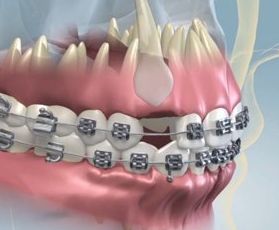Teeth are defined including those teeth that do not erupt or that erupt only in part by getting stuck in the bone or gum.
The teeth most subject to inclusion are wisdom teeth, i.e. third molars, the last permanent teeth that should appear between the ages of 18 and 25. Followed by the frequency of inclusion are the canines: this phenomenon involves about 1% of the population especially in the 7-11 age range. On the inclusion of canines, given their chewing and aesthetic function, once the diagnosis has been confirmed, the therapeutic solution is immediately proceeded to limit the damage as much as possible.
The included teeth in fact exert a pressure that affects the entire dental arch, generating as a first consequence of the problems of occlusion or altered positioning of the other teeth.
Another not inconsiderable consequence is that the included or partially included teeth are easily subject to being attacked by the bacterial plaque which in the long run can cause tooth decay and inflammation of the gum.
What factors determine the case of included teeth?
The inclusion of teeth can be generated by several causes, the most frequent are:
- presence of a narrow dental arch or palate;
- supernumerary teeth;
- fall or trauma of a deciduous tooth before the time necessary for the eruption of the permanent tooth;
- crooked teeth;
- genetic diseases.
How do you work on the included teeth?
A qualified and competent dentist will adopt a specific therapeutic solution after carefully analyzing the patient’s clinical case; in fact, contrary to what one might think, the therapeutic approach for the included teeth is not always extraction.
We can say that extraction is more frequent when the inclusion of the teeth concerns the third molars, i.e. the wisdom teeth. This is justified by the fact that wisdom teeth, thanks to the evolution of the species with the consequent reduction of the maxillary bones, are no longer necessary and therefore useful for chewing. Extraction is therefore a choice often recommended when wisdom teeth remain included or do not find a correct location, assuming anomalous positions that can cause significant clinical complications.
 The case of the canines included, on which it is possible to intervene with a traction therapy, is different: that is, guiding the canine from the gum to its correct seat in the dental arch. This treatment assumes the application of an orthodontic appliance that acts as an anchor for the orthodontic wire that connects the included part of the tooth to the appliance. Thanks to the pulling force, the canine is pulled out and aligned in the arch.
The case of the canines included, on which it is possible to intervene with a traction therapy, is different: that is, guiding the canine from the gum to its correct seat in the dental arch. This treatment assumes the application of an orthodontic appliance that acts as an anchor for the orthodontic wire that connects the included part of the tooth to the appliance. Thanks to the pulling force, the canine is pulled out and aligned in the arch.
As we have repeatedly stressed, entrusting your clinical case to a dental center of excellence and with cutting-edge technologies means having a personalized therapy for each diagnosis that takes into account the patient’s medical history and its actual needs.
















